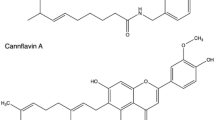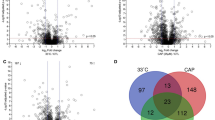Abstract
Capsaicin is the most abundant pungent molecule identified in red chili peppers, and it is widely used for food flavoring, in pepper spray for self-defense devices and recently in ointments for the relief of neuropathic pain. Capsaicin and several other related vanilloid compounds are secondary plant metabolites. Capsaicin is a selective agonist of the transient receptor potential channel, vanilloid subfamily member 1 (TRPV1). After exposition to vanilloid solution, Caenorhabditis elegans wild type (N2) and mutants were placed on petri dishes divided in quadrants for heat stimulation. Thermal avoidance index was used to phenotype each tested C. elegans experimental groups. The data revealed for the first-time that capsaicin can impede nocifensive response of C. elegans to noxious heat (32–35 °C) following a sustained exposition. The effect was reversed 6 h post capsaicin exposition. Additionally, we identified the capsaicin target, the C. elegans transient receptor potential channel OCR-2 and not OSM-9. Further experiments also undoubtedly revealed anti-nociceptive effect for capsaicin analogues, including olvanil, gingerol, shogaol and curcumin.





Similar content being viewed by others
References
Szallasi A, Blumberg PM (1999) Vanilloid (capsaicin) receptors and mechanisms. Pharmacol Rev 51:159–212
Yardim Y (2011) Sensitive detection of capsaicin by adsorptive stripping voltammetry at a boron-doped diamond electrode in the presence of sodium dodecylsulfate. Electroanalysis 23(10):2491–2497
Ochoa-Alejo N (2006) Capsaicin accumulation in Capsicum spp. suspension cultures. Methods Mol Biol 318:327–334
Caterina MJ, Schumacher MA, Tominaga M, Rosen TA, Levine JD, Julius D (1997) The capsaicin receptor: a heat-activated ion channel in the pain pathway. Nature 389:816–824
Cortright DN, Szallasi A (2004) Biochemical pharmacology of the vanilloid receptor TRPV1. Eur J Biochem 271:1814–1819
Knotkova H, Pappagallo M, Szallasi A (2008) Capsaicin (TRPV1 Agonist) therapy for pain relief: farewell or revival? Clin J Pain 24(2):142–154
Klein AH, Trannyguen M, Joe CL, Lodi CM, Carstens E (2005) Thermosensitive transient receptor potential (TRP) channel agonists and their role in mechanical, thermal and nociceptive sensations as assessed using animal models. Chemosens Percept 8(2):96–108
Smart D, Jerman JC, Gunthorpe MJ, Brough SJ, Ranson J, Cairns W, Hayes PD, Randall AD, Davis JB (2001) Characterisation using FLIPR of human vanilloid VR1 receptor pharmacology. Eur J Pharmacol 417(1–2):51–58
Jancso G, Dux M, Oszlacs O, Santha P (2008) Activation of the transient receptor potential vanilloid-1 (TRPV1) channel opens the gate for pain relief. Br J Pharmacol 155:1139–1141
Wittenburg N, Baumeister R (1999) Thermal avoidance in Caenorhabditis elegans: an approach to the study of nociception. Proc Natl Acad Sci USA 96(18):10477–10482
Kahn-Kirby AH, Bargmann CI (2006) TRP channels in C. elegans. Annu Rev Physiol 68:719–736
Glauser DA, Chen WC, Agin R, MacInnis B, Hellman AB, Garrity PA, Man-WahTan, Goodman MB (2011) Heat avoidance is regulated by transient receptor potential (TRP) channels and a neuropeptide signaling pathway in Caenorhabditis elegans. Genet Soc Ame 188:91–103
Venkatachalam K, Luo J, Montell C (2014) Evolutionarily conserved, multitasking TRP channels: lessons from worms and flies. Handb Exp Pharmacol 223:937–962
Tobin DM, Madsen DM, Kahn-Kirby A, Peckol EL, Moulder G, Barstead R, Maricq AV, Bargmann CI (2002) Combinatorial expresson of TRPV channel proteins defines their sensory functions and subcellular localisation in C. elegans neurons. Neuron 35:307–318
Nkambeu B, Ben Salem J, Leonelli S, Amin Marashi F, Beaudry F (1019) EGL-3 and EGL-21 are required to trigger nocifensive response of Caenorhabditis elegans to noxious heat. Neuropeptides 73:41–48
Alsalem M, Millns P, Altarifi A, El-Salem K, Chapman V, Kendall DA (2016) Anti-nociceptive end desensitizing effects of olvanil of capsaicin-induced thermal hyperalgesia in the rat. BMC Pharmacol Toxicol 17(31):1–11
Zhu X, Li Q, Chang R, Yang D, Song Z, Guo Q, Huang C (2014) Curcumin alleviates neuropathic pain by inhibiting p300/CBP histone acetyltransferase activity-regulated expression of BDNF and Cox-2 in rat model. PLoS ONE 9(3):1–9
Bhattarai S, Tran VH, Duke CC (2001) The stability of Gingerol and Shogaol in aqueous solutions. J Pharm Sci 90(10):1658–1664
Walpole CSJ, Bevan S, Bovermann G, Boelsterli JJ, Breckenridge R (1994) The discovery of capsazepine, the first competitive antagonist of the sensory neuron excitants capsaicin and resiniferatoxin. J Med Chem 37:1942–1954
Geng S, Zheng Y, Meng M, Guo Z, Cao N (2016) Gingerol reverses the cancer-promoting effect of capsaicin by increased TRPV1 level in urethane-induce lung carcinogenic model. J Agric Food Chem 64:6203–6211
Kim E-C, Min J-K, Kim T-Y, Lee S-J, Yang H-O (2005) [6]-Gingerol, a pungent ingredient of ginger, inhibits angiogenesis in vitro and in vivo. Biochem Biophys Res Commun 335:300–308
Brenner S (1974) The genetics of Caenorhabditis elegans. Genetics 77(1):71–94
Margie O, Palmer C, Chin-Sang I (2013) C. elegans chemotaxis assay. J Vis Exp 74:1–6
Porta-De-La-Riva M, Fontrodona L, Villanueva A, Cerón J (2012) Basic Caenorhabditis elegans methods: synchronization and observation. J Vis Exp 64:1–9
Mori I, Ohshima Y (1995) Neuralregulationofthermotaxis in Caenorhabditis elegans. Nature 376:344–348
Koutarou DK, Atsushi M, Kunihiro M, Ikue M (2004) The C. elegans thermosensory neuron AFD responds to warming. Curr Biol 14:1291–1295
Liu S, Schulze E, Baumeister R (2012) Temperature- and touch-sensitive neurons couple CNG and TRPV channel activities to control heat avoidance in Caenorhabditis elegans. PLoS ONE 7(3):1–13
Groninger H, Schister RE (2012) Topical capsaicin for neuropathic pain #255. J Palliat Med 15(8):946–947
Lee JY, Shin TJ, Choi JM, Seo KS, Kim HJ (2013) Antinociceptive curcuminoid, KMS4034, effects on inflammatory and neuropathic pain likely via modulating TRPV1 in mice. Br J Anaesth 111(4):667–672
Viswanadhan VN, Sun Y, Norman MH (2007) Three-dimensional quantitative structure–activity relationships and activity predictions of human TRPV1 channel antagonists: comparative molecular field analysis and comparative molecular similarity index analysis of cinnamides. J Med Chem 50(23):5608–5619
Salat K, Filipek B (2015) Antinociceptive activity of transient receptor potential channel TRPV1, TRPA1, and TRPM8 antagonists in neurogenic and neuropathic pain models in mice. J Zhejiang Univ Sci B 16(3):167–178
Jones VM, Moore K, Peterson D (2011) Capsaicin 8% topical patch (Qutenza)—a review of the evidence. J Pain Palliat Care Pharmacother 25:32–41
Gauthier M-L, Beaudry F, Vachon P (2013) Intrathecal [6]-Gingerol administration alleviates peripherally induced neuropathic pain in male Sprague-Dawley rats. Phytother Res 27(8):1251–1254
Tamburini N, Bollini G, Volta AC, Cavallesco G, Maniscalco P, Spadaro S, Qurantotto F, Ragazzi R (2018) Capsaicin patch for persistent postoperative pain after thoracoscopic surgery, report of two cases. JOVS 4(3):1–4
Acknowledgements
This project was funded by the National Sciences and Engineering Research Council of Canada (F. Beaudry discovery Grant No. RGPIN-2015-05071). Laboratory equipment was funded by the Canadian Foundation for Innovation (CFI) and the Fonds de Recherche du Québec (FRQ), the Government of Quebec (F.Beaudry CFI John R. Evans Leaders Grant No. 36706). A PhD scholarship was awarded to J. Ben Salem with a Grant obtained from Fondation de France.
Author information
Authors and Affiliations
Corresponding author
Ethics declarations
Conflict of Interest
The authors declared they have no conflict of interest.
Additional information
Publisher's Note
Springer Nature remains neutral with regard to jurisdictional claims in published maps and institutional affiliations.
Rights and permissions
About this article
Cite this article
Nkambeu, B., Salem, J.B. & Beaudry, F. Capsaicin and Its Analogues Impede Nocifensive Response of Caenorhabditis elegans to Noxious Heat. Neurochem Res 45, 1851–1859 (2020). https://doi.org/10.1007/s11064-020-03049-4
Received:
Revised:
Accepted:
Published:
Issue Date:
DOI: https://doi.org/10.1007/s11064-020-03049-4




